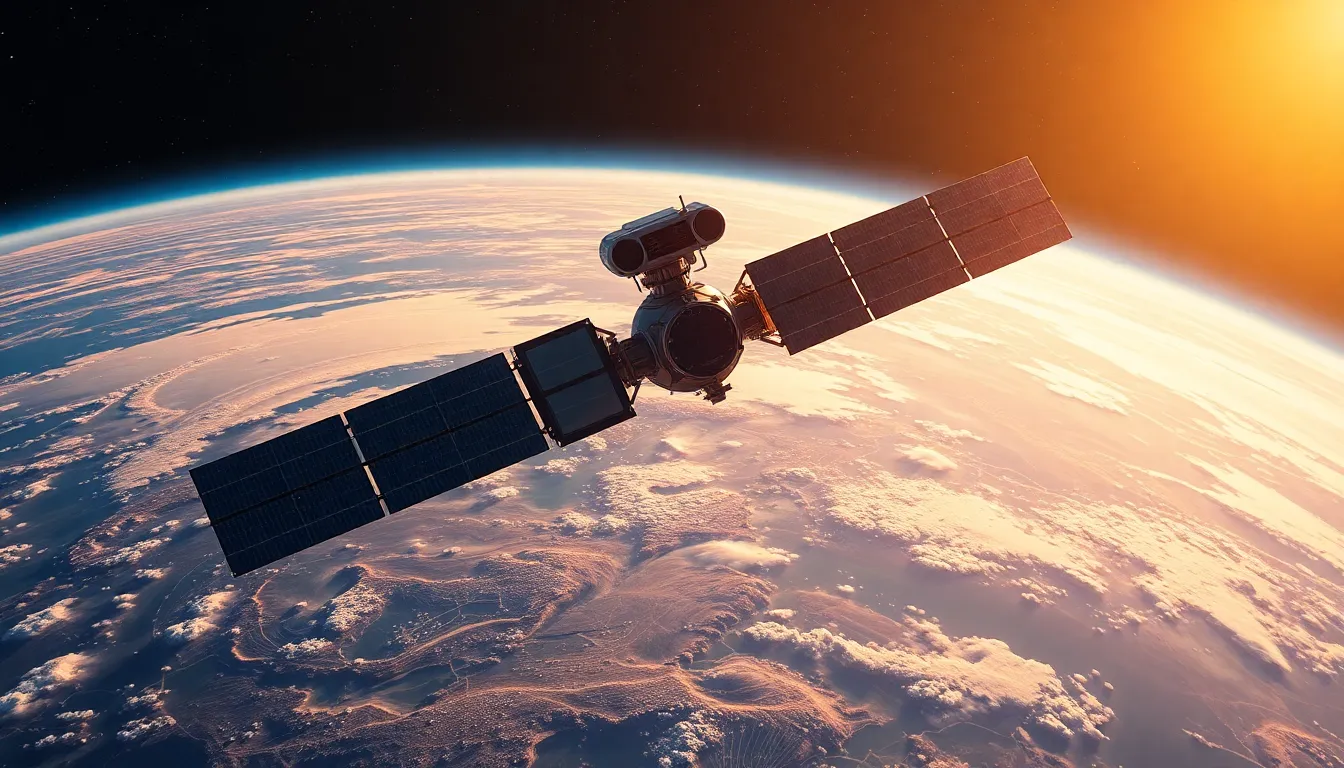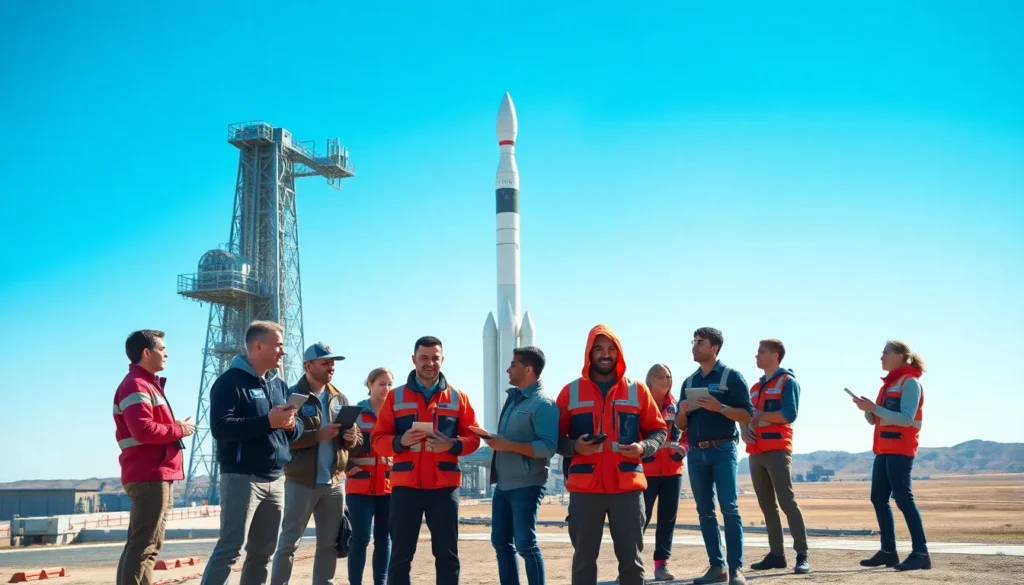Table of Contents
ToggleIn a world where rockets are the new sports cars and satellites are practically the new pigeons, space technology advancements are blasting off at an astonishing pace. From reusable rockets that make launching into the cosmos look like a weekend hobby to satellites that can spot your backyard barbecue from orbit, the future of space exploration is brighter than a supernova.
Overview of Space Technology Advancements
Space technology has evolved significantly in recent years, transforming the landscape of exploration and research. Reusable rockets play a pivotal role in reducing launch costs and increasing accessibility to space. Companies such as SpaceX and Blue Origin have pioneered these innovations, demonstrating the feasibility of landing rockets after each mission.
Satellites have also seen considerable advancements, with capabilities for high-resolution imaging and real-time data transmission. High-definition Earth observation satellites provide crucial information for climate monitoring, disaster management, and urban planning. Their enhanced sensors enable scientists to collect comprehensive data for various applications.
Artificial intelligence (AI) and machine learning increasingly support space missions. These technologies analyze large datasets, optimizing operations and decision-making processes. For example, AI systems contribute to navigating spacecraft and managing resources effectively.
Additionally, advancements in propulsion systems contribute to the efficiency of space travel. Ion thrusters and solar sails offer alternatives to traditional chemical propulsion, allowing spacecraft to achieve greater distances and speeds. These innovations create opportunities for exploration beyond our solar system.
International collaboration is a key trend in space technology development. Countries unite to share knowledge and resources, leading to groundbreaking projects like the International Space Station. Such partnerships enhance research and foster innovation, expanding humanity’s reach into the cosmos.
These technological strides illustrate the dynamic nature of space exploration. As innovations continue to emerge, the possibility of accessible and enhanced space travel becomes increasingly tangible. The future holds immense potential for both scientific discovery and commercial opportunities in space.
Key Innovations in Space Technology

Space technology has undergone significant innovations, contributing to enhanced capabilities for exploration and communication.
Satellite Technology Improvements
Advancements in satellite technology include high-resolution imaging and real-time data transmission. Newer satellites provide detailed observations crucial for climate monitoring and disaster management. Enhanced sensors enable collection of data with unprecedented accuracy. Companies are developing smaller, more efficient satellites, often referred to as CubeSats, which reduce launch costs. These miniature satellites can perform the same tasks as larger counterparts, thus democratizing access to space data. Furthermore, satellite constellations formed by numerous small satellites improve global coverage and communication.
Propulsion Systems Breakthroughs
Breakthroughs in propulsion systems enable spacecraft to achieve greater speeds and travel longer distances. Ion thrusters, which utilize electric fields to accelerate ions, offer efficient fuel consumption and longer operational lifespans. Solar sails harness sunlight to propel spacecraft, representing a novel approach to interstellar travel. Additionally, hybrid propulsion systems combine traditional rocket fuels with newer technologies, leading to improved performance. Enhanced propulsion capabilities optimize mission profiles, allowing for more ambitious exploration targets, such as Mars and beyond.
Robotics and Automation in Space
Robotics and automation play a crucial role in space missions, enhancing operational efficiency. Robotic arms on spacecraft assist with various tasks, from satellite deployment to repairs in orbit. Autonomous systems enable spacecraft to make real-time decisions, improving mission success. Advances in artificial intelligence allow robots to analyze complex data, facilitating scientific research. Drones and rovers explore planetary surfaces, gathering information that would be challenging for humans to obtain. Such innovations expand the potential for human exploration by reducing risks in space.
Impact on Space Exploration
Space technology advancements significantly reshape exploration efforts. Innovations usher in new possibilities for uncovering the mysteries of the universe.
Mars Missions and Beyond
Propulsion breakthroughs enhance Mars missions. The development of efficient ion thrusters enables spacecraft to cover vast distances. Companies like SpaceX aim for crewed Mars missions, targeting timelines as early as 2026. Robotic explorers, including rovers, support these missions by gathering data on the Martian surface. Collaborative international projects also contribute resources and expertise, increasing mission feasibility and success rates. As advancements continue, aspirations extend beyond Mars, eyeing the moons of Jupiter and Saturn for potential exploration.
Reducing Costs for Space Travel
Reducing costs transforms space travel into a more accessible endeavor. Reusable rockets significantly lower launch expenses, as demonstrated by SpaceX’s Falcon 9. Traditional single-use rockets often incur millions in costs, whereas reusable options cut that figure dramatically. A growing number of private companies drive this cost-reduction trend, fostering competition in the space sector. Additionally, enhanced satellite technology minimizes expenses related to data collection and communication. Lower costs elevate opportunities for research and commercial ventures, democratizing access to space and its vast resources.
Commercialization of Space Technology
The commercialization of space technology accelerates innovation and expands opportunities for exploration and development. This trend involves increased participation from private companies, enhancing competition and fostering advancements.
Private Sector Involvement
Private sector involvement plays a pivotal role in the evolution of space technology. Companies like SpaceX and Blue Origin spearhead initiatives, driving down launch costs and improving access to space. These organizations develop reusable rocket systems, which significantly reduce financial barriers. Partnerships with established aerospace firms enable startups to leverage existing expertise and infrastructure. As investments grow, more startups emerge, focusing on satellite development, space tourism, and asteroid mining.
Benefits of Public-Private Partnerships
Public-private partnerships cultivate shared resources and expertise, amplifying accomplishments in space exploration. Collaborative efforts enable government agencies to tap into private ingenuity and funding, accelerating project timelines. These partnerships lower research and development costs, allowing for more ambitious missions. Joint ventures also facilitate technology transfer, benefitting both public entities and private innovators. Enhanced access to data and infrastructure leads to comprehensive national security and scientific advancements. Such synergies bolster the potential for discovering new resources beyond Earth.
Future Trends in Space Technology
Space technology is evolving rapidly, promising exciting developments. Innovations strive not only for exploration but also prioritize sustainability for future endeavors.
Sustainable Space Exploration
Sustainable practices in space exploration focus on minimizing environmental impact. Reusable rockets exemplify this commitment by significantly lowering waste associated with launches. Additionally, initiatives for in-situ resource utilization (ISRU) allow future missions to produce fuel and other essentials from planetary resources. These advancements lessen dependency on Earth supplies, enabling longer missions and deeper exploration. Solar power usage aboard spacecraft further contributes to sustainability, providing renewable energy for prolonged operations. As sustainability becomes a core principle, opportunities for eco-friendly technologies expand, ensuring humanity’s presence in space aligns with planetary stewardship.
Emerging Technologies on the Horizon
Several promising technologies emerge as key players in the future of space exploration. Artificial intelligence enhances data processing and operational efficiency, offering automated solutions for mission management. Next-generation propulsion systems, like nuclear thermal engines, could drastically shorten travel times to distant destinations, including Mars. Additionally, 3D printing capabilities allow for on-demand production of parts in space, reducing the amount of equipment transported from Earth. Advances in quantum communication also show potential for secure and instantaneous data transfer across vast distances. These innovations collectively transform mission possibilities, paving the way for deeper exploration and commercial endeavors.
The landscape of space technology is evolving at an unprecedented pace. Innovations in reusable rockets and advanced satellite systems are not just enhancing exploration but also making it more accessible. With private companies leading the charge and international collaborations strengthening efforts, the future of space exploration looks promising.
Sustainability is becoming a central theme as technologies like in-situ resource utilization and solar power take center stage. These advancements not only reduce environmental impact but also pave the way for longer missions beyond Earth. As humanity aims for ambitious targets like Mars and the moons of Jupiter, the potential for scientific discovery and commercial ventures in space continues to expand. The journey has just begun, and the cosmos awaits.




